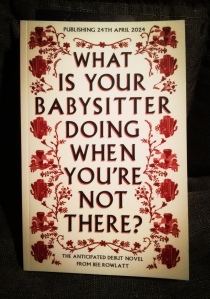As you’ll probably guess if you read the Ramblings regularly, I tend to be quite selective when it comes to reading modern fiction. A lot of it is not for me, and I lean more towards the classics, modern classics, non-fiction and translated writing. However, when Will at Renard approaches me with something more current, I pay attention; he publishes intriguing, sometimes quirky and always interesting modern fiction, and I’ve enjoyed a number of titles Renard have issued. Therefore, I was happy to receive an advance copy of a new book which is out today, and which has an intriguing strapline; the book is “One Woman Crime Wave” by Bee Rowlatt, and as the proof cover asks, “What is your babysitter doing when you’re not there?”.
Fifteen year old Ashleigh has the reputation of being the best babysitter in the neighbourhood, and is having her first job with a dreadful pair of lovies, Tara and Giles. Their daughter Betsy seems to be shuttled between nanny Samira and babysitters, and it can’t be said that her parents are particularly hands on. However, as we observe Ashleigh at her job, it’s clear she has some kind of agenda… She may present as the perfect teenager, but in fact she’s a deeply troubled girl with a difficult family set-up, and as she goes through Tara’s house with forensic attention to detail, the reader can’t help wondering what she’s after.
Gradually, as the narrative progresses, parts of her past are revealed. Her mother is dead, and she lives with sister Morgan and dad Ludi. Tara’s house was previously their home, now converted from flats back into a posh middle class dwelling. However, despite the material trappings, Tara is not happy either. She’s struggling to restart her career after having Betsy, beginning to loathe her husband Giles, and despite lording it over the other mums at the playground gate (and repelling those like Holly who might not be from her class), she’s not getting the attention she needs. When Samira suggests that little Betsy might need to be tested for autism, that’s the trigger for Tara to take her rage out on the nanny and as well as sacking her, she takes some pretty unpleasant action.
This was why she loved the law. Every case had a proper ending. Each interconnected part was necessary, like completing a chain. Nothing dangled or straggled or was left unresolved.
Samira herself is an interesting character; part of a small family of refugees from Iraq, she’s studying for law and all her widowed father’s hopes are focused on her. Tara’s actions will potentially damage her plans, but Samira is not one to take things lying down. As events build to a dramatic conclusion, all of the characters will find their lives changed; but whose will be for the better and whose for the worse?
To say any more would spoil the pleasure of reading the book and watching the story develop. I have to say, though, that I was very invested in the characters, particularly Ashleigh and Samira; both girls have different ways of kicking back against the hand life has dealt them, and I was cheering them on! The skewering of Toxic Tara and Ghastly Giles is a joy to see; I’ve run across their type many a time, both when taking my own Offspring to school and also in my current school-based job… However, the villains are not all middle class, with Rowlatt allowing nuance in her portrayal of characters from all backgrounds and communities.
Central to the story, I feel, are women trying to take control of their own lives and come to terms with past traumas and present difficulties. Both Ashleigh and Samira have much to deal with, and seem determined to improve their situation, but Tara has pretty much made her own bed and now has to lie on it. Running through the book are themes of class, race and the veneer we put on when dealing with others. Tara, Giles and their set seem inherently racist and dismissive of anyone they deem as different or beneath them, so it’s comforting to see their world crumble. This is a book very much about secrets; all families have them, and as the narrative progresses and lives unravel, those secrets become revealed in dramatic ways. And interestingly, the question arises as to whom, actually, does the title of the book refer? Is Ashleigh’s nosing and pilfering the crime, or does Tara’s behaviour raise more red flags?
As you can probably tell, “One Woman Crime Wave” is a fascinating read which tells a gripping story whilst exploring many topics and issues; and it struck me that we’re really not moving on in our modern, fractured world where we’re very far away from an integrated and supportive society with opportunities and consideration for all. Ashleigh and Samira have different ways of dealing with their issues, and although Ashleigh’s are perhaps not the best, they’re understandable. The way the two women’s lives interact and enable resolution is cleverly done, and Rowlatt’s debut novel is a real success. Previously known for her work in journalism and non-fiction, it’s clear she has a talent for storytelling, and the short, sharp chapters in “One Woman…”, focusing on the different characters, keep you engaged all the way through.
So another winner from Renard! As well as producing beautiful editions of classics and essays, poetry and plays, they’re also carving out a niche for excellent and often quirky modern fiction. As I said, this is not a kind of writing I often read, but it’s great to be taken out of your comfort zone and I do recommend “One Woman Crime Wave” as a pithy, engrossing and thought-provoking look at modern life! 😀























